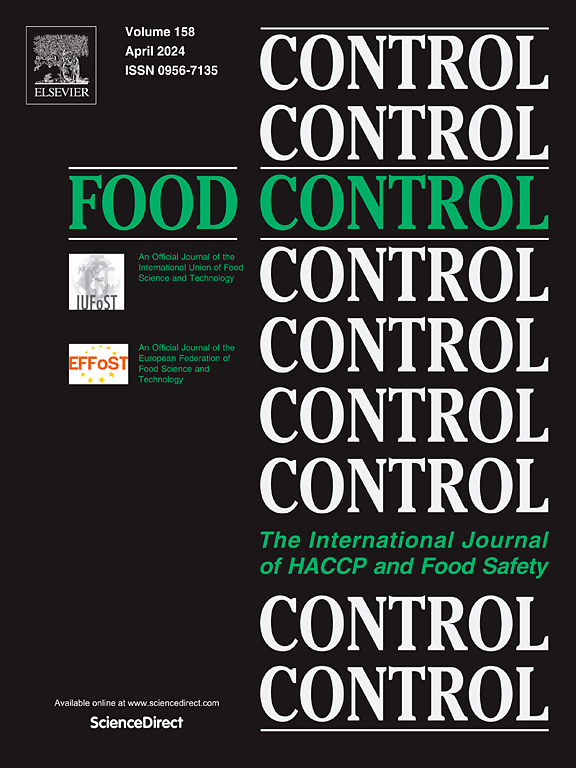pvkk -叠加:一种基于光谱数据多样性和元特征优化的铁观音掺假分析新方法
IF 6.3
1区 农林科学
Q1 FOOD SCIENCE & TECHNOLOGY
引用次数: 0
摘要
茶叶掺假检测是食品安全监管的一个关键挑战,特别是乌龙茶,由于其品种之间的物理化学性质相似,以及传统鉴定方法的局限性。光谱技术以其无损、准确、高效的特点,为这一挑战提供了有效的解决方案。然而,考虑到掺假成分的复杂性和多样性,传统的基于光谱分析的单个模型通常预测精度有限,跨品种泛化能力差,无法用于不同掺假场景的检测。为了解决这一技术瓶颈,提出了一种新颖的pvkk叠加方法。该方法结合多种光谱预处理和变量选择方法,为基础模型生成多样化的光谱数据,为叠加集成学习提供全面的补充信息。此外,通过K-means聚类对基础模型进行修剪,随后使用KPLSR元模型进行整合。本研究的重点是检测经典乌龙茶铁观音中的掺假,使用其他四种高度相似的乌龙茶品种制备掺假样品。实验结果表明,PVKK-Stacking方法相对于个体模型和集合方法有一定的改进,并且表现出优异的稳定性,具有可靠的跨品种泛化能力。此外,PVKK-Stacking作为一种集成学习方法,对其进行了优化,减少了预测时间。该方法为乌龙茶掺假检测提供了高度可靠的解决方案,对保证乌龙茶质量安全具有重要的实用价值。本文章由计算机程序翻译,如有差异,请以英文原文为准。
PVKK-Stacking: A novel stacking method based on spectral data diversity and meta-feature optimization for adulteration analysis of Tieguanyin tea
Tea adulteration detection poses a critical challenge in food safety regulation, particularly for oolong tea, due to the similar physicochemical properties among its varieties and the limitations of conventional identification methods. Spectroscopic techniques, with their non-destructive, accurate, and efficient characteristics, offer an effective solution to this challenge. However, given the complexity and diversity of adulterant compositions, traditional individual models based on spectral analysis generally suffer from limited prediction accuracy and poor cross-variety generalization, making them inadequate for detection across different adulteration scenarios. To address this technical bottleneck, a novel PVKK-Stacking method was proposed. This method combined multiple spectral preprocessing and variable selection methods to generate diverse spectral data for the base models, thereby provided comprehensive complementary information for the stacking ensemble learning. Furthermore, base models were pruned through K-means clustering and subsequently integrated using a KPLSR meta-model. This study focused on detecting adulteration in Tieguanyin, a classic oolong tea, using four other highly similar oolong tea varieties to prepare adulterated samples. Experimental results demonstrated that the PVKK-Stacking method achieved certain improvements over the compared individual model and ensemble methods, and exhibited exceptional stability, demonstrating reliable cross-variety generalization capability. Moreover, as an ensemble learning method, PVKK-Stacking has been optimized to reduce prediction time. The proposed method provides a highly reliable solution for detecting oolong tea adulteration, holding significant practical value in ensuring tea quality and safety.
求助全文
通过发布文献求助,成功后即可免费获取论文全文。
去求助
来源期刊

Food Control
工程技术-食品科技
CiteScore
12.20
自引率
6.70%
发文量
758
审稿时长
33 days
期刊介绍:
Food Control is an international journal that provides essential information for those involved in food safety and process control.
Food Control covers the below areas that relate to food process control or to food safety of human foods:
• Microbial food safety and antimicrobial systems
• Mycotoxins
• Hazard analysis, HACCP and food safety objectives
• Risk assessment, including microbial and chemical hazards
• Quality assurance
• Good manufacturing practices
• Food process systems design and control
• Food Packaging technology and materials in contact with foods
• Rapid methods of analysis and detection, including sensor technology
• Codes of practice, legislation and international harmonization
• Consumer issues
• Education, training and research needs.
The scope of Food Control is comprehensive and includes original research papers, authoritative reviews, short communications, comment articles that report on new developments in food control, and position papers.
 求助内容:
求助内容: 应助结果提醒方式:
应助结果提醒方式:


